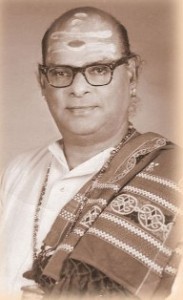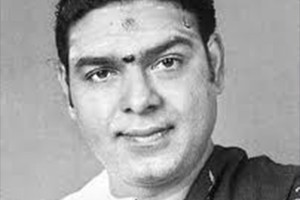Vazhuvoor Style Bharthanatyam
Vazhuvoor style of Bharatanatyam which originated in the village of Vazhuvoor. Known actually as Vazhuvoor, this village in the vicinity of Mayiladuturai in Thanjavur district is the native place of Ramaiah Pillai, who popularised this style of Bharatanatyam.
Shrimathy Thiripurasundari Yaganantham’s Guru Vazhuvoor Ramaish Pillai
Vazhuvoor Ramiah Pillai was a unique teacher. He trained his students with dedication and instilled into them the need to give of their best to Bharatha Natyam. Vazhuvoor Ramiah Pillai was born into a Isai Vellalar family, the traditional breeding ground of dancers and musicians, Ramiah Pillai was a dance master cast in the traditional mould.
The temple at Vazhuvoor village is dedicated to Lord Siva, under the name of Gannasabeshan, and to this day, the students of Vazhuvoor school, pay obeisance to the deity Gannasabeshan in the form of Thodaya mangalam at the beginning of each dance recital. Vazhuvoor Ramiah Pillai trained numerous dance teachers, such as Thiripurasundari Cumarasamy who is the first student to go from Jaffna Srilanka and others like Kumari kamala, Vyjayanthimala Padmini Padma Subramanyam who are from India and numerous outstanding dancers of today.
Shrimathy Nandini Suthahar’s Guru Vazhuvoor R.Samaraj
The Vazhuvoor style was continued by his son Vazhuvoor R.Samaraj who was in Mylapore Chennai. This rich style focuses on the beauty of movement, picturesque poses blending with a charming graceful technique that gave visual delight. The Vazhuvoor style is accredited with introducing the aspect of entering from the wings as opposed to starting a dance-piece on stage. The dance-steps are crisp and intricate but combined with grace and beautiful eye movements.
Poses are often introduced in the pieces especially in the tillana to add space in time. The jatis or nritta units have more karvais or gaps than usual to add a sense of time being suspended giving the dance an exciting quality. The body from the waist up is slanted slightly forward to give more dimensions to the body. The adavus or dance units are done smoothly without too many jerky movements to give an impression of effortlessness and elegance and beautiful leaps mark every jati.
Abhinaya or narrative expression is subtle with more natyadharmi or naturally stylized expressions and there is no obviousness in the presentation. The hands, eyes, and expressions are used in unison to express eloquently. Lasya, or grace, is predominant in this style. Traditionally, a performance in the Vazhuvoor style begins with a Thodaya mangalam in praise of Lord Gnana Sabesar of Vazhuvoor.
Popular dancers, such as Vidhya Subramanian, along with Kamala Lakshman, Padma Subramanyam, Chitra Viswesvaran have increased the exposure of this style.
The Vazhuvoor style of Bharata natyam includes:
• wide range of dancing pace
• static postures are inserted, most often in the tillana, to break the monotony and to add the variety of rhythms
• softer facial abhinaya
• abhinaya is subtle with more natyadharmi (spontaneous expressions), so the presentation is not “overdone”
• the adavu’s flow smoothly, with rare abrupt movements
• extremely elaborate movements
• deep sitting positions
• variety of positions on the floor
• rich shringara elements
• lasya dominates tandava
• the dancer’s body from the waist up is stlightly bent forward
• leaps are introduced into every jati
• the jati’s have more korvais (intervals), which creates a suspense effect
• performance begins with a Thodaya mangalam in honour of Lord Gnana Sabesar of Vazhuvoor
• the dancer starts the performance while entering the stage from the wings


